
Topics
The Bush Administration has announced that former President Bill Clinton and former U.S. Ambassador to the United Nations Richard Holbrooke will lead the U.S. delegation to East Timor’s independence ceremony on May 20. [includes rush transcript]
The remarks of U.S. officials praising East Timor’s independence will likely ignore the ugly history of American support for Indonesia’s invasion and occupation of East Timor from 1975 to 1999. Their remarks will also likely ignore the efforts of the Bush administration to restore full military aid to the Indonesian armed forces in the name of the so-called war on terrorism. This despite Indonesia’s unwillingness to bring to justice high-ranking military officials responsible for the campaign of terror and destruction inflicted on East Timor by the Indonesian military and its paramilitary proxies, following the population’s overwhelming vote for independence in an August 30, 1999 referendum sponsored by the U.N. Indonesian General Hendropriyono, who helped to orchestrate the military’s campaign to force nearly 300,000 Timorese from their homes into neighboring West Timor, is now head of Indonesian intelligence and the Bush Administration’s chief liaison for its “counter-terrorism” efforts in Indonesia.
After surviving the November 12, 1991, Santa Cruz massacre, in which Indonesian troops killed more than 270 East Timorese in a cemetery in the capital of Dili, Amy Goodman and journalist Alan Nairn produced the 1992 radio documentary Massacre: The Story of East Timor. As East Timor nears its independence, Massacre offers a chilling reminder of the priorities which guided U.S. policy toward Indonesia and East Timor during a quarter century of occupation, priorities which remain in place today.
Tape:
- “Massacre: The Story Of East Timor,” Amy Goodman and Allan Nairn’s 1992 documentary about the Santa Cruz Massacre.
Transcript
AMY GOODMAN: You’re listening to Democracy Now!: Breaking the Sound Barrier in East Timor. Today we’re standing in front of the Motael Church. Ten years ago, on November 12th, 1991, young people just like this, thousands of them, gathered outside the church. They weren’t holding xylophones and cymbals and drums. They were holding banners that said things like “Why the Indonesia military shoot our church?” They came out of the church, where the nuns are now watching this procession. But on that day, they marched, and it wasn’t Timorese who were coming along in jeeps to watch a parade. It was the Indonesian military that lined the route. Today, it’s young people. They are practicing for the Independence Day celebration on Sunday. Then, too, it was young people who pulled the banners written on bed sheets out of their blouses, from their schools, the kinds of blouses that we see today. Today, they’re celebrating. In 1991, they were gunned down. This is the new East Timor.
Today we go back in time to a radio documentary journalist Allan Nairn and I produced more than 10 years ago on the history of East Timor and the Santa Cruz massacre, then a wide-ranging interview with rebel leader turned president Xanana Gusmão.
JOSÉ RAMOS-HORTA: I lost one sister and two brothers.
EAST TIMORESE WOMAN: It was 10 days before I was to give birth. The army was shooting people, and they would die at our feet, but you couldn’t stop to help them.
JOSÉ RAMOS-HORTA: I know families that were totally wiped out.
EAST TIMORESE MAN: Two American newsmen badly beaten: Mr. Allan Nairn and Miss Amy Goodman.
AMY GOODMAN: The Indonesian army converged in two places.
ALLAN NAIRN: Hundreds and hundreds of troops coming straight at the Timorese.
AMY GOODMAN: When they came, they opened fire on the people.
PRESIDENT GEORGE H.W. BUSH: We pride ourselves, and I think properly so, in standing up for human rights.
RICHARD BOUCHER: Military assistance programs expose the trainees to democratic ideas and humanitarian standards.
PRESIDENT BILL CLINTON: I’m very concerned about what’s happened in East Timor. We have ignored it so far in ways that I think are unconscionable.
AMY GOODMAN: Massacre: The Story of East Timor. I’m Amy Goodman.
JAMES BAKER: Big countries with powerful military machines should not be permitted to invade, occupy and brutalize their peaceful neighbors.
AMY GOODMAN: With these words, former Secretary of State James Baker explained why the United States was going to war against Iraq. Yet, 16 years earlier, another big country, Indonesia, invaded a much smaller one, East Timor, with the support of the United States. What followed was one of the greatest genocides of the 20th century. It is estimated that up to one-third of the Timorese population has been killed through a policy of army massacre and enforced starvation. Many of those who are left have been imprisoned and tortured by a military armed and trained by the United States.
East Timor, a quiet farming nation on a mountainous island about 300 miles north of Australia, had been a Portuguese colony until 1974, when there was a democratic revolution in Portugal and the new government decided to disband its empire. Neighboring Indonesia, a military dictatorship more than 200 times East Timor’s size, began attacking Timor in an effort to prevent the island nation from completing its move toward independence. On December 7, 1975, Indonesia launched a full invasion. Timorese shortwave radio, monitored by reporters in Australia, was heard putting out desperate calls for help.
TIMORESE SHORTWAVE RADIO: A lot of people are being killed—I repeat—indiscriminately. More than a thousand troops have been added.
AMY GOODMAN: The night before the invasion, Secretary of State Henry Kissinger and President Ford were in the Indonesian capital of Jakarta, toasting General Suharto, the Indonesian ruler.
PRESIDENT GERALD FORD: Our relationship involves a common concern for the right of every nation to pursue its destiny on its own independent and sovereign course. On behalf of Mrs. Ford and myself, I raise my glass and propose a toast.
AMY GOODMAN: João Carrascalão, the brother of the former governor of East Timor and himself a political leader now in exile, was working for the Indonesians at the time.
JOÃO CARRASCALÃO: I arrived at Jakarta one hour before President Ford and Henry Kissinger landed in Jakarta. And on the same night, I was informed by Colonel Suyanto—he was a top officer in the Jakarta administration—that America had given the green light for Indonesia to invade Timor.
AMY GOODMAN: The United States, Suharto’s main backer, supplied 90 percent of Indonesia’s arms. The story of East Timor is a story few know about, except those who have lived through it. Six foreign journalists who were there as Indonesia attacked were executed by the Indonesian military. Australian TV correspondent Greg Shackleton sent this report the night before the frontier town where he was visiting was seized by the Indonesian troops.
GREG SHACKLETON: Why, they ask, are the Indonesians invading us? Why, they ask, are the Australians not helping us? Who, they ask, will pay for the terrible damage to our homes?
My main answer was that Australia would not send forces here. That’s impossible. However, I said, we could ask that Australia raise this fighting at the United Nations. That was possible. At that, the second in charge rose to his feet, exclaimed, “Camerado journalist!” shook my hand, the rest shook my hand, and we were applauded, because we are Australians. That’s all they want: for the United Nations to care about what is happening here.
The emotion here last night was so strong that we, all three of us, felt we should be able to reach out into the warm night air and touch it. Greg Shackleton in an unnamed village, which we’ll remember forever, in Portuguese Timor.
AMY GOODMAN: And it was to be a report Australians would remember. The following day, Indonesian troops moved in and executed Shackleton and his crew. Though the government of Australia ended up siding with Indonesia, the U.N. Security Council denounced the invasion of East Timor and passed two resolutions like those later passed against Iraq, calling on Indonesia to withdraw its troops without delay. But United States lobbying prevented any U.N. action, and as Indonesia began to execute the Timorese en masse, Washington doubled its military aid.
I first arrived in East Timor in the summer of 1990. Almost 16 years after the Indonesian army first came to shore, they were still occupying East Timor. I was there with journalist Allan Nairn, a correspondent for The New Yorker magazine.
ALLAN NAIRN: Dili, the capital city, was honeycombed with army bases and torture houses. There were soldiers on the street corners, secret police watching the market stalls and the public parks. Timorese could be hauled away to the torture houses if they were found speaking to foreign tourists or listening to foreign shortwave radio. There, people would be given electroshock, beaten with iron bars. And at night, soldiers wearing hoods would roam through the neighborhoods terrorizing the Timorese.
AMY GOODMAN: Journalist Allan Nairn and I returned to East Timor in order to be present for a historic event. A special delegation from the United Nations and Portugal was due to visit East Timor. The Timorese hoped the visit would finally lead to U.N. action and enforcement of the Security Council resolutions calling on Indonesia to withdraw from East Timor.
ALLAN NAIRN: We were told in place after place that the army had been holding neighborhood and village meetings to warn the Timorese that if they tried to speak to the U.N. Portuguese delegation, they and their families would be killed. And Bishop Belo, the bishop of East Timor, told us that the threat was: “We will kill your family to the seventh generation.”
AMY GOODMAN: But despite the threats and a dramatic increase in disappearances, torture and deaths, Timorese had prepared to speak out. They had met in secret, making banners and petitions for the delegation. When the army tried to hunt them down, many had gone into hiding and sought refuge inside churches. But under pressure from the United States, the visit of the delegation had been called off. Three days later, with the world’s spotlight removed, the army stormed the Motael, Dili’s main Catholic church, and killed a young man named Sebastião Gomes, who had taken refuge there.
And then came the morning of November 12, the two-week commemoration of Sebastião’s funeral. A memorial mass and procession were planned to lay flowers on Sebastião’s grave. After the mass was held at the Motael, people, young and old, came out into the street, and in a land where public speech and assembly had been forbidden over a decade, they started chanting. The Timorese then held up banners drawn on bed sheets. They had been prepared for the delegation that never came. The banners called on Indonesia to leave East Timor and said things like “Why the Indonesian army shoot our church?” The Timorese were facing a gauntlet of troops that stretched the length of Dili. It was the boldest act of public protest occupied Timor had ever seen.
ALLAN NAIRN: More and more Timorese joined the procession. They came from huts and schools and offices along the way. And there was this building feeling of exhilaration, as well as fear, among the Timorese. And when they reached the cemetery, the crowd had swelled to maybe 5,000 people. Some went inside to lay flowers on Sebastião’s grave. Most of the crowd was still outside. And then suddenly, someone looked up, and we saw that marching up along the same route that the Timorese had come came a long column of Indonesian troops, dressed in brown, holding M16s in front of them, marching in a very slow, deliberate fashion, hundreds and hundreds of troops, coming straight at the Timorese.
AMY GOODMAN: Allan suggested we walk to the front of the crowd between the soldiers and the Timorese, because although we knew that the army had committed many massacres, we hoped that we, as a foreign journalists, could serve as a shield for the Timorese. Standing with headphones on and microphone and camera out in full view, we went and stood in the middle of the road, looking straight at the approaching troops. Behind us, the crowd was hushed as some Timorese tried to turn away, but they were hemmed in by cemetery walls.
ALLAN NAIRN: The soldiers marched straight up to us. They never broke their stride. We were enveloped by the troops, and when they got a few yards past us, within a dozen yards of the Timorese, they raised their rifles to their shoulders all at once, and they opened fire. The Timorese, in an instant, were down, just torn apart by the bullets. The street was covered with bodies, covered with blood. And the soldiers just kept on coming. They poured in, one rank after another. They leaped over the bodies of those who were down. They were aiming and shooting people in the back. I could see their limbs being torn, their bodies exploding. There was blood spurting out into the air. The pop of the bullets, everywhere. And it was very organized, very systematic. The soldiers did not stop. They just kept on shooting until no one was left standing.
AMY GOODMAN: A group of soldiers grabbed my microphone and threw me to the ground, kicking and punching me. At that point, Allan threw himself on top of me, protecting me from further injury. The soldiers then used their rifle butts like baseball bats, beating Allan until they fractured his skull. As we sat on the ground, Allan covered in blood, a group of soldiers lined up and pointed their M16s at our heads. They had stripped us of all of our equipment. We just kept shouting, “We’re from America!” In the end, they decided not to execute us.
ALLAN NAIRN: The soldiers beat us, but we actually had received privileged treatment. We were still alive. They kept on firing into the Timorese. We were able to get onto a passing civilian truck, went into hiding, but the Timorese, who had been with us there on the cemetery road, most of them were dead.
AMY GOODMAN: Inside the cemetery walls, Max Stahl, a filmmaker on assignment with Yorkshire TV, had had his video camera running.
MAX STAHL: The soldiers began at that point to encircle the entire cemetery. I saw soldiers as they gradually moved towards the middle, picking out people who were wounded or taking refuge between the tombstones, and when they got to them, they beat them and assembled them in the back of the cemetery. People were stripped to their waists. They had their thumbs tied behind their backs, and they were made to look at the ground. And if they looked up, they were immediately beaten, usually with a rifle butt.
AMY GOODMAN: Max Stahl was filming near a crypt in the middle of the cemetery. Some of the wounded and those too scared to run were huddled inside praying. As Stahl filmed, he buried his videocassettes in a fresh grave. Then he was arrested by the troops.
MAX STAHL: Whilst I was being interrogated, I observed these trucks driving by with more people in them. These people were clearly in a kind of paralysis of fear. They were not able to move. Some of them, at least in the cemetery and, indeed, even in the trucks, when I saw them going by, were barely breathing. When people are that terrified, it’s quite often difficult to tell if they’re dead or alive.
AMY GOODMAN: After nine hours in custody, Stahl went back to the cemetery under cover of night, dug up his videocassettes and had them smuggled out of the country. Allan Nairn and I had managed to leave East Timor a few hours after the massacre. From a hospital on Guam, we reported what had happened to dozens of newspapers, radio and television outlets around the world.
PACIFICA REPORT: From Washington, this is the Pacifica report for Tuesday, November 12, 1991. A massacre in East Timor. Among those injured were two journalists, including a news editor of Pacifica station WBAI in New York.
AMY GOODMAN: They beat me and dragged me over and started slamming me with rifle butts and kicks and punches, and then Allan jumped on top of me, and they beat him very badly. But that was the least of what they did. They opened fire on the people, and these were truly defenseless people…
MONTAGE OF WORLD NEWS FOOTAGE: When Indonesian troops opened fire on a crowd—This is CBC Radio—The massacre of 100 unarmed Timorese by the Indonesian military—Photographs of the bloody massacre during a fight for freedom—This is the CBS Evening News.
AMY GOODMAN: In the face of the massacre story, even Suharto’s longtime allies were compelled to condemn the killings and came under public pressure to cut back their aid to Indonesia. In Australia, large crowds marched on the capital and surrounded Indonesia’s local consulates. The European Parliament voted for sanctions against Indonesia, and the European community later canceled a scheduled trade pact. There were even open protests inside Indonesia where student demonstrators were beaten and arrested.
AMY GOODMAN: You’re listening to Massacre: The Story of East Timor, here on Democracy Now! Back in a minute.
[break]
AMY GOODMAN: This is Democracy Now!: The Exception to the Rulers, as we continue with the documentary Massacre: The Story of East Timor.
AMY GOODMAN: Back in the United States, the Bush administration continued to ship weapons to Indonesia.
PRESS SECRETARY: Ladies and gentlemen, the President of the United States.
AMY GOODMAN: The only time President Bush mentioned East Timor publicly was months after the massacre, when asked about it by a Portuguese journalist.
PRESIDENT GEORGE H.W. BUSH: A lot of discussion is going on on the tragedy in East Timor. We have expressed ourself in terms of the pure human rights part of it. We pride ourselves, and I think properly so, in standing up for human rights, and I think we’ve made clear to the parties that are interested there the U.S. position. I don’t know how it will come out…
AMY GOODMAN: That position: to call for an increase in U.S. military training aid. It’s called IMET, International Military Education and Training. More than 2,600 Indonesian officers have been trained under IMET since 1975. They include those who planned the invasion and have overseen the policy of mass slaughter. Immediately after the massacre, General Try Sutrisno, the National Commander of the Indonesian Armed Forces, gave a speech to a military gathering. He said of the Timorese who dared to oppose the Indonesian Armed Forces, “They must be shot,” adding, “and we will shoot them.”
Listening to politicians is something José Ramos-Horta has been doing for 17 years. He left East Timor at the age of 25, just before Indonesia invaded. He had been sent to the United Nations to plead East Timor’s case. While Ramos-Horta got out of East Timor alive, much of his family has been killed.
JOSÉ RAMOS-HORTA: I lost one sister and two brothers. The sister, she was 17 when she was killed, along with 20 other kids. Two Bronco aircraft nosedive over a village and blew up the school and the 20 kids there. One brother was killed when he was captured. Another, we don’t know what exactly happened, but he disappeared during a helicopter assault on my village, where he was.
But like me, there are many, many other families, and in fact, some are even worse. I know families that were totally wiped out, families that I knew, I grew up with, that no longer exist. I know villages, when all my youth I spent there, and when I ask survivors, I’m told that village does no longer exist. It’s not on the map. So, this is the scale of the tragedy that was imposed on East Timor, with U.S.A. complicity.
AMY GOODMAN: How do you hold out hope? You’ve been outside the country for 17 years. You’ve been the representative of East Timor at the United Nations for more than a decade. What gives you any hope?
JOSÉ RAMOS-HORTA: Well, the past 17 years that I’ve been engaging in diplomatic struggle, I also have witnessed—and all of us witnessed—empires crumbling. No one thought possible five years ago, 10 years ago, that the Soviet Union would disintegrate into independent states, or Yugoslavia or the Berlin Wall, democratization in Africa and elsewhere. And Indonesia will follow the same. It cannot escape the train of democracy. But apart from that, the resistance in East Timor is continuing at all levels—armed resistance, one, but also cultural, religious. The entire people are mobilized. And we are very confident. I can state categorically, in the next three, five years, six years, maybe a bit longer, East Timor is going to be independent.
AMY GOODMAN: Today, José Ramos-Horta is the external spokesperson for the Timorese underground and its leader, Xanana Gusmão. Xanana leads the remnants of the Timorese guerrilla resistance, which has been fighting in the hills for 17 years. But perhaps his most important role is as the political leader of the Timorese underground, which advocates self-determination and, as even the Indonesian army admits, enjoys vast support across the political spectrum among the surviving East Timorese.
*No matter how hard the army has tried to catch him, Xanana has eluded their grasp. He has emerged as the symbol of national resistance, a figure of Nelson Mandela-like stature in East Timor.
XANANA GUSMÃO: [translated] We are not saddened with our pain. We open our eyes to the immense suffering of the 16 years. We are not afraid of blood. We think of the determination of our people. The struggle continues on every front.
TIMORESE ORPHANS: [translated] I laid awake at 4:00 a.m. I woke up, and I couldn’t find anybody. Mother and father, where are you? You left me all alone.
AMY GOODMAN: Old women in traditional dress of East Timor, young men, young women, little kids, and they marched up to the cemetery. When we got to the cemetery, again there were thousands of people. The Indonesian army converged in two places. They beat me and dragged me over and started slamming me with rifle butts and kicks and punches. And then Allan jumped on top of me, and they beat him very badly. But that was the least of what they did. They opened fire on the people.
AMY GOODMAN: Massacre: The Story of East Timor. When journalist Allan Nairn and I produced this documentary in 1992, Xanana Gusmão was the rebel leader of the East Timorese people. He was then captured by the Indonesian military, after fighting in the mountains against the army for 17 years, held in an Indonesian prison for eight years. Now, in just four days, he will become the founding president of the new nation of East Timor.

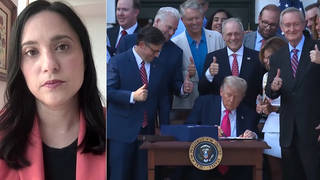
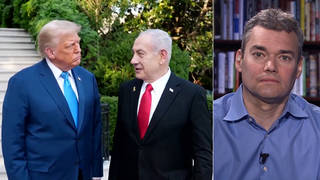

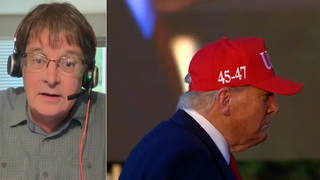
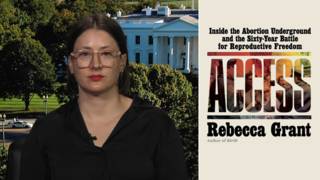
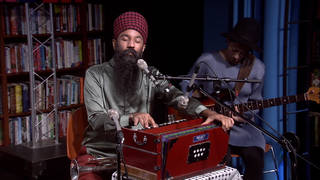
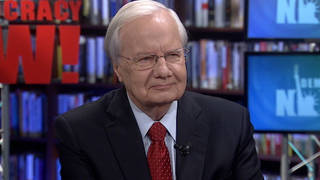
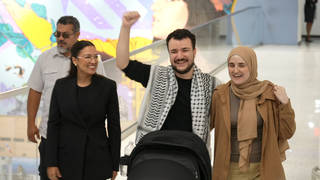



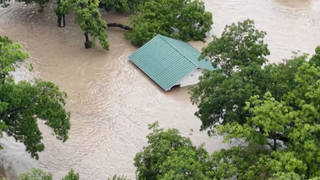
Media Options